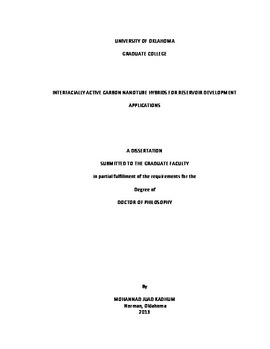| dc.contributor.advisor | Resasco, Daniel | |
| dc.contributor.author | Kadhum, Mohannad | |
| dc.date.accessioned | 2013-12-04T17:44:46Z | |
| dc.date.available | 2013-12-04T17:44:46Z | |
| dc.date.issued | 2013-12 | |
| dc.identifier.uri | https://hdl.handle.net/11244/7689 | |
| dc.description.abstract | This work examines the different aspects of stabilizing and propagating interfacially active carbon nanohybrids for oil field applications. The progress achieved during the last four years was quite impressive towards the objective of utilizing nanoparticles for potential in situ applications.
In this work we examined the interactions between nanohybrids and a reservoir-like environment. This has been done by performing a series of adsorption isotherms, column studies, and Coreflood tests. An optimized system of nanohybrids dispersed using binary dispersing polymers (GA and HEC-10) showed almost negligible adsorption of the nanohybrids to crushed Berea sandstone in the order of ≈0.01 mg/gsand in extreme conditions of salinity up to 20% and temperature up to 80oC. Propagation column studies were performed using crushed Berea sand to propagate nanohybrids dispersions successfully with C/Co approaching 1 following 5-6 pore volumes of dispersion injection with a P-MWNT concentration as low as 100 ppm. This is because once available adsorption sites get saturated, the nanohybrids dispersion will propagate completely with no significant losses. Coreflood experiments have been performed both in labs at the University of Oklahoma and the Stim-Lab in Duncun, OK. Coreflood results using Stim-Lab standardized core testing verified the previous findings. Ability to propagate nanohybrids dispersion successfully through a 6” length Berea 400 core with C/Co as high as 97% and particles overall recovery exceeding 84% was demonstrated. Noteworthy is the increased retention of nanoparticles in the presence of oil phase inside the core because of the nanohybrids interfacial activity. Following successful propagation of nanohybrids through consolidated porous media, novel potential applications have been investigated including using nanohybrids as surfactant carriers and for logging while drilling NMR and EPR reservoir characterization tools.
Series of experiments to investigate the ability of nanohybrids to generate or stabilize foams were conducted. A boost in foam stability was achieved by incorporating nanoparticles during foam generation. Nanohybrids were found to increase foam stability significantly by using concentrations as low as 100ppm of nanohybrids.
As a proof of concept for utilizing nanohybrids in performing in situ reactions for EOR, a series of reaction column studies using catalytically functionalized carbon nanotubes were performed. Reactions have been conducted to investigate the possibility of increasing oil recovery by partial oxidation of tetralin, a molecule containing two carbon rings with an easily oxidizable alpha carbon to produce tetralone, which in turn has less interfacial tension with water than tetralin. Lowering the interfacial tension results in lowering capillary forces which in turn increases oil recovery. It was found that 6% of the residual oil is recovered by conducting partial oxidation reaction using air flow at 90oC and 300 psi, which in turn suggests the viability of this technique for increasing oil recovery. | en_US |
| dc.language | en_US | en_US |
| dc.subject | Engineering, Chemical. | en_US |
| dc.title | INTERFACIALLY ACTIVE CARBON NANOTUBE HYBRIDS FOR RESERVOIR DEVELOPMENT APPLICATIONS | en_US |
| dc.contributor.committeeMember | Harwell, Jeffrey | |
| dc.contributor.committeeMember | Shiau, Ben | |
| dc.contributor.committeeMember | Papavassiliou, Dimitrios | |
| dc.contributor.committeeMember | Crossley, Steven | |
| dc.date.manuscript | 2013-11 | |
| dc.thesis.degree | Ph.D. | en_US |
| ou.group | College of Engineering::School of Chemical, Biological and Materials Engineering | |
